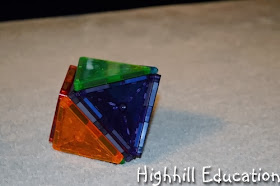Platonic solids are found many places in nature and have fascinated great thinkers throughout history. There are five different Platonic Solids. The name Platonic comes from the Greek philosopher Plato, so this activity is perfect to do in conjunction with an Ancient Greek Unit Study. We did in in conjunction with the Renaissance, as Leonardo da Vinci and Fibonacci also studied Platonic Solids.
Platonic solids are constructed from regular polygons with identical faces. In addition, the same number of faces meet at each vertex. Tetrahedron, octahedron and icosahedron are all constructed from triangles. Tetrahedron have four faces, octahedron have eight and icosahedron have twenty. The cube is constructed from squares and dodecahedron are constructed from pentagons. They have twelve faces.
Tetrahedron
Octahedron
Cube
Icosahedron - It didn't work with the Magna-Tiles.
To make the paper icosahedron, 20 equilateral triangles were sketched on a sheet of paper so that the sides were touching.
Next, the triangles were cut in one piece, folded on the lines and joined at the edges. Small tabs of paper were left on some triangles to make the icosahedron easier to assemble.
Paper Icosahedron
This icosahedron post gives more information on how to make the paper icosahedron above, as well as the one below.
Origami Triambic Icosahedron
The following two videos explain the five Platonic solids and give examples of polyhedron which do not meet the criteria for Platonic solids.
After watching the video, several colorful sketches of the Platonic Solids in their wire frame and three-dimensional forms were created. Since the video showed each of the views, it was easy to watch and then pause at the proper point to create the drawings.

* I did not receive any compensation for this recommendation. I'm just a homeschooling mom who has found many products that I like. If you're interested in the products I recommend on this blog I want to make it easy for you to find them.
** I am an Amazon associate and receive a small portion of the sales on orders made after clicking in from this site, which I promptly spend on homeschooling books and supplies for my children.











This is really good! Thanks for sharing. I love the posters. They really show that the children have understood the concepts well.
ReplyDeleteWhat a wonderful lesson! I love when math can tie into history as well =)
ReplyDelete